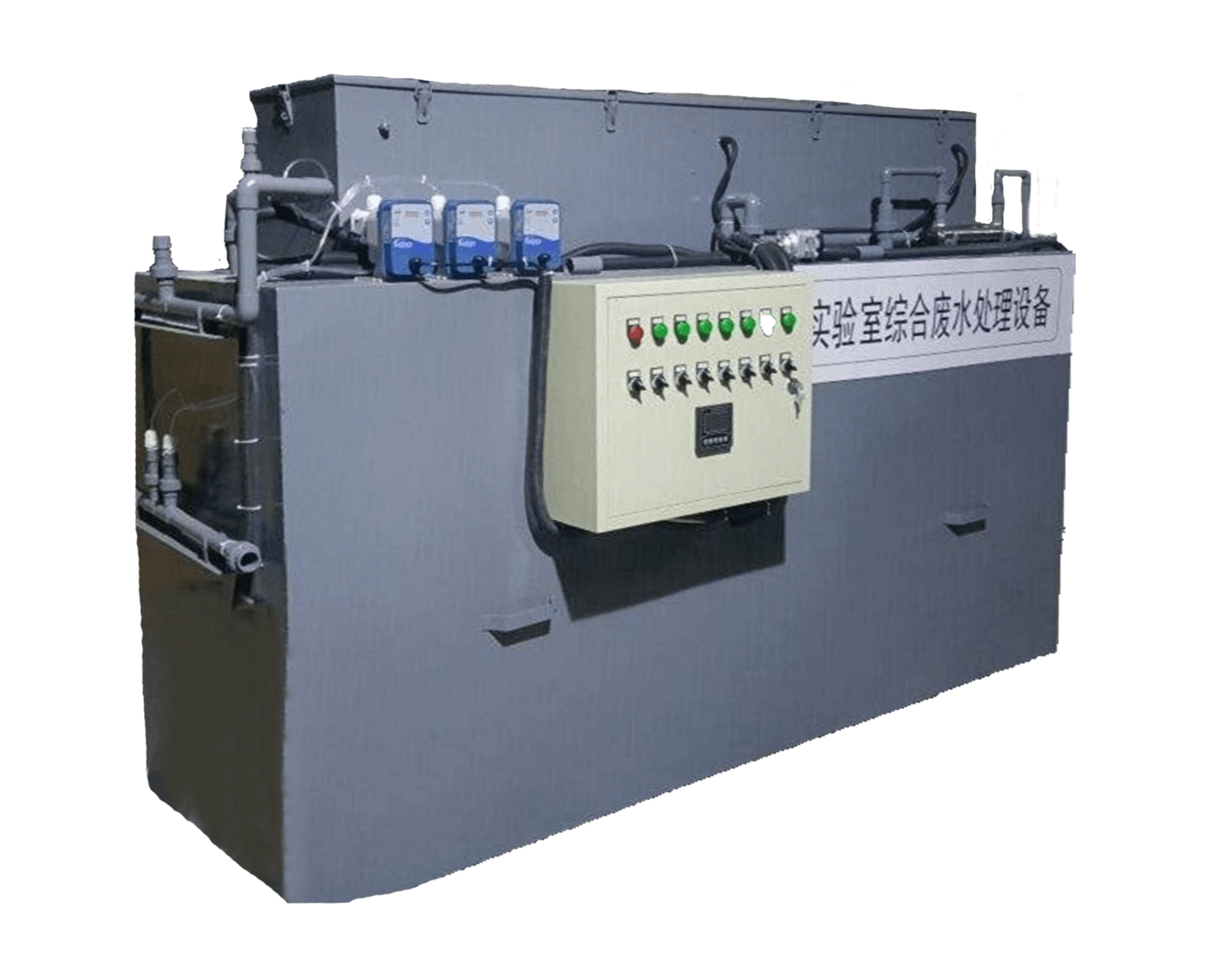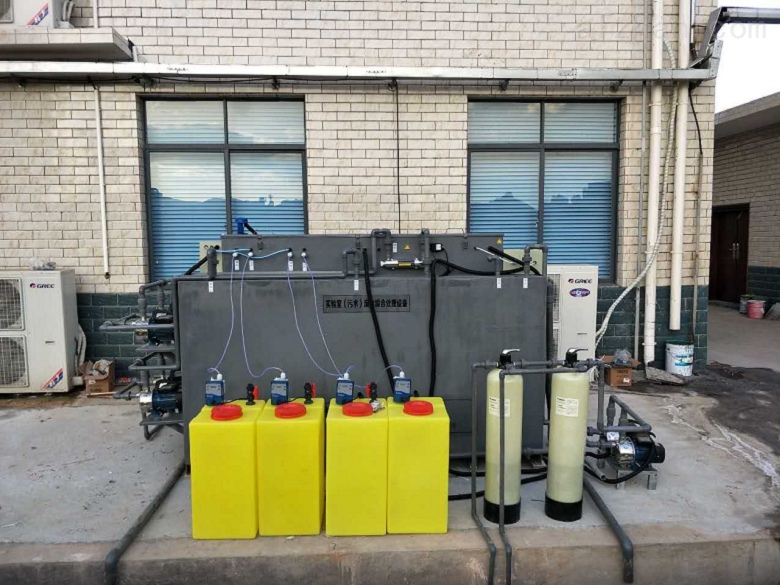Shandong Lingke Environmental Protection Technology Co., Ltd.
Email:lk@lingkezhitong.com
Address:12th Floor, Block B, Wanda Plaza, Kuiwen District, Weifang City, Shandong Province
Fax:0536-8812014
Websitewww.lingkezhitong.com

LK "Lingke Zhitong" laboratory integrated wastewater treatment system consists of wastewater collection unit, automatic regulation unit, pretreatment unit, automatic dosing unit, coagulation air flotation stirring unit, flocculation and sedimentation unit, sedimentation and separation unit, solid-liquid separation unit, sludge drying unit, heavy metal capture unit, filtration and adsorption unit, new catalytic activity micro-electrolysis treatment unit, high and low level. Potential difference micro-electrolysis technology treatment unit, electrochemical catalytic oxidation-reduction technology treatment unit, photocatalytic oxidation technology treatment unit, multi-pass advanced decomposition and degradation treatment unit, two-stage organic biological activity treatment unit, new biological reaction treatment unit, compound disinfection treatment unit, new filled bed light wave catalytic reaction technology of organic wastewater and other technological processes Composition, forming a complete laboratory integrated wastewater treatment system. The system is operated by PLC programmable control system and human-machine interface operation system, remote monitoring and operation system. The system is operated automatically according to the program set by the PLC controller and the parameters set by the PH/ORP automatic control instrument, and multi-level automatic on-line monitoring is carried out. According to the composition and concentration of different laboratory wastewater, the control system automatically calculates and then automatically dispenses drugs according to the proportion, which is more scientific and rational, ensures the treatment effect, and saves the consumption of drugs without special duty.
LK "Lingke Zhitong" laboratory integrated wastewater treatment equipment uses different treatment technologies and processes for different organic, inorganic and biological wastewater components and concentrations produced by different laboratories. It can effectively remove COD, BOD, SS, chroma, virus, organic solvents and heavy metal ions in the laboratory integrated wastewater.
Waste water analysis
1. Laboratory wastewater sources: laboratory drugs, reagents, test solution, laboratory wastewater collected after the experiment, residual reagents, expired laboratory reagents and other comprehensive wastewater;
2. Laboratory wastewater components: inorganic, organic and biological wastewater, etc.
1) Inorganic compounds: heavy metal ions, acid-base PH values, halogen ions and other non-metallic ions, etc.
A. Heavy metal ions: mercury, cadmium, total chromium, hexavalent chromium, lead, manganese, silver, nickel, zinc, iron, cobalt, tin, magnesium, zinc, copper, aluminium, arsenic and other metal cations in the state of complexation (Cr2O7) 2-, (CuCN) -, (AuCN) -, (Ptcl6) 2-, etc.
B. Non-metallic ions: fluoric acid or fluoride, free cyanide or cyanide, complex ion compound, AsO32-, AsO43-, Hg+, Hg2+, etc.
C, pH value of acid and base: nitric acid, hydrochloric acid, phosphoric acid, sulfuric acid, hydrogen peroxide, potassium chloride, calcium chloride, etc.
2) Organic substances: organic solvents, detergents, surfactants, benzene, toluene, xylene, aniline, phenol, polychlorinated biphenyls, benzopyrene, phenols, formaldehyde, acetaldehyde, acrylonitrile, acrolein, alkanes, alkenes, hydrogen fluoride, petroleum, oils and fats, methanol, aniline, polycyclic aromatic hydrocarbons, nitro compounds, nitrosamines, chloroanilines, nitrobenzene, ethers Mixed hydrocarbons, binones, carbohydrates, halogenated hydrocarbons, proteins, organophosphorus pesticides, etc.
3) Biology: pathogens, etc.
Pathogens: bacteria, viruses, chlamydia, mycoplasma, spirochetes, fungi, brucella, anthrax, etc.
Waste water treated by laboratory integrated wastewater treatment system can be directly discharged into municipal sewage pipe network.

Operating Photographs
Functional Characteristics of LK "Lingke Zhitong" Laboratory Integrated Wastewater Treatment System
1. Wide practicability: It can be used in wastewater treatment of various laboratories.
2. * Technology: A number of advanced * technologies are used to treat and purify the comprehensive wastewater in a multi-process way, which fully meets the discharge standards.
3. High degree of automation: centralized control, friendly man-machine interface, simple operation, full-automatic operation, without special duty;
4. Automatic protection function: automatic protection function of leakage or leakage, automatic protection function of high and low voltage, no waste water protection function, liquid level protection function of each treatment unit, overload protection function of electrical equipment, overload protection function of electrical circuit;
5. Timing automatic cleaning function: the system regularly cleans the parts that need to be cleaned automatically, and the service life of the parts is longer;
6. Low operating cost: low power, low energy consumption; stable operation, fewer faults, low maintenance cost; long service life of consumables, low cost of consumables; automatic dosing according to proportion, low consumption of drugs; no need for dedicated duty, free of dedicated management costs, etc.
7. Environmentally friendly: the system adopts double mute motor and anti-corrosion pump, which has low noise; the whole process adopts closed treatment, no odor, no leakage, no secondary environmental pollution such as waste residue, waste water, waste gas, etc.
8. Intelligent integration: Through the "one-stop" integrated design, it has the advantages of small area, fast processing speed, convenient installation and movement, real engineering equipment, beautiful appearance and no need to dig multiple treatment pools;
Present Situation of Laboratory Wastewater Pollution
With the development of science and technology in China, more and more laboratories are needed. Especially in the past decade, the number of laboratories is increasing. From the point of view of the distribution of laboratories, they are mainly concentrated in the industries of middle and higher education institutions, scientific research institutes, medical institutions, biopharmaceuticals, disease control, environmental monitoring, product quality inspection, drug testing, blood stations, livestock, hospitals and enterprises. The discharge of laboratory wastewater is not large, and its pollution is easy to be neglected.
Laboratory is actually a typical serious source of pollution. Pollutants are often neglected. The more construction, the greater the total amount of pollution. In our country, the wastewater produced by laboratories is usually discharged directly into the underground sewage pipe network without treatment or simple treatment and sent to large domestic sewage treatment plants for centralized treatment. Because of the complex composition of laboratory sewage, especially the heavy metals such as lead, mercury, cadmium, hexavalent chromium, copper, antimony, ferrous, aluminium, manganese, and a large number of pathogens such as bacteria, viruses, insect eggs, as well as chemical agents and radioisotopes, the facilities of domestic sewage treatment plants are "powerless" and can only be discharged into rivers. These laboratories, especially chemical laboratories in central urban areas and residential areas, are particularly harmful to the environment. For historical reasons, many chemical laboratories'drainage pipes are connected with residential drainage pipes. Pollutants form cross-contamination, acute and latent infections through sewers, and eventually flow into rivers or underground, and heavy metals enter water sources or soil. After the soil, it may enter the human food chain through many ways. According to medical data, heavy metals such as lead and mercury can cause diseases of nervous system, digestive system and blood. Therefore, the direct discharge of laboratory wastewater does immeasurable harm to water resources and the environment.
With the enhancement of people's awareness of environmental protection and the improvement of relevant environmental regulations, laboratory wastewater treatment has become one of the evaluation items of laboratory management system. Therefore, it is of great significance to the comprehensive treatment of laboratory wastewater.


Live photography
Introduction of Main Processing Methods
LK "Lingke Zhitong" Laboratory Comprehensive Sewage Treatment System developed by Shandong Lingke Environmental Protection Technology Co., Ltd. consists of wastewater classification collection unit, wastewater regulation unit, wastewater pretreatment unit, advanced wastewater treatment unit, dosing unit, sedimentation separation unit, physical treatment unit, chemical treatment unit, physical and chemical treatment unit, biological treatment unit and terminal comprehensive depth. Degree purification unit, terminal PH regulating unit, monitoring unit and other components, the main processing methods are as follows.
1) Physical method: separation of suspended or opaque substances in wastewater by means of grids, centrifugation, clarification, filtration and oil separation;
2) Chemical method: using acid-base neutralization, coagulation, flocculation and precipitation to remove inorganic or colloidal substances in wastewater;
3) Physicochemical methods: using physical and chemical methods such as adsorption, redox, catalytic oxidation, photocatalytic oxidation, compound disinfection and sterilization technology, high and low potential difference micro-electrolysis technology, electrochemical redox* technology to remove inorganic and organic substances or colloidal substances in wastewater;
4) Biological treatment: through two-stage organic biofilm purification, biofilm method, new bioreactor and other methods for treatment.
The inorganic, organic and biological wastewater produced in the laboratory can be comprehensively treated by the above treatment processes, which can effectively remove COD, BOD, SS, chroma and heavy metal ions in wastewater. Different treatment technologies and control systems are used to treat wastewater according to the composition of the experimental wastewater.